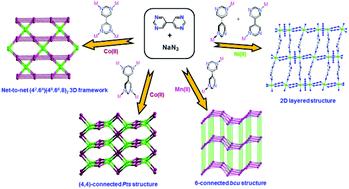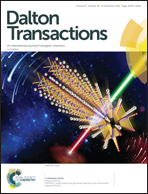The use of a semi-flexible bipyrimidyl ligand for the construction of azide-based coordination polymers: structural diversities and magnetic properties†
Abstract
Using a semi-flexible quadritopic N-donor ligand, 5,5′-bipyrimidine (bpym), four new azide-based coordination polymers, {[Co2(bpym)(N3)4]·MeCN}n (1), [Co(bpym)(N3)2]n (2), [Mn(bpym)(N3)2]n (3) and {[Ni3(bpym)3(N3)6]·2H2O}n (4) were synthesized and structurally characterized. With bpym aciting as a planar μ4-bridging ligand, the resulting compound, 1, comprised a net-to-net 3D framework composed of two grid-like 44-subnets, Co(EE-N3)2-based and Co2(bpym)-based sheets, with a (4,6)-connected (42·64)(48·66·8)2 topology. Compound 2 adopted a 3D pillared-layer framework with a pts topology based on six-connected Co(II) centers and four-connected twisted μ4-bpym ligands, while compound 3 adopted a 3D pillared-layer structure with a bcu topology based on Co(EE-N3)2-based 44-layers and two-connected twisted μ2-bpym pillars. In contrast, compound 4 had a 2D layered structure composed of 1D Ni(II) chains with alternating double EE–N3 and double EO–N3 bridges in an EE–EE–EO sequence and two-connected bpym linkers. The magnetic properties of 1–4 were investigated. The findings indicate that 1 showed weak ferromagnetism due to spin-canted antiferromagnetism and long-range magnetic ordering with a critical temperature, TC = 12.6 K. In contrast, compound 2 exhibited weak ferromagnetism due to spin-canted antiferromagnetism and antiferromagnetic ordering. In compound 3, antiferromagnetic interactions dominated between the Mn(II) centers through the EE–N3 bridges. In compound 4, the antiferromagnetic and ferromagnetic interactions were transmitted through double EE–N3 and double EO–N3 bridges, respectively, resulting in an AF–AF–F topological ferrimagnetic Ni(II) chain. Furthermore, field-induced magnetic phase transitions of metamagnetism for 2 and 4 were also observed below TN = 3.6 K and 8.2 K, respectively.



 Please wait while we load your content...
Please wait while we load your content...